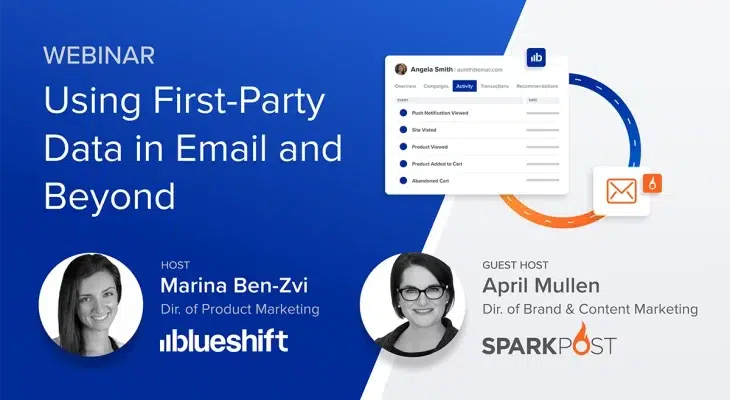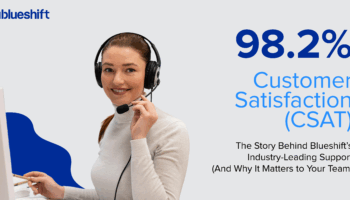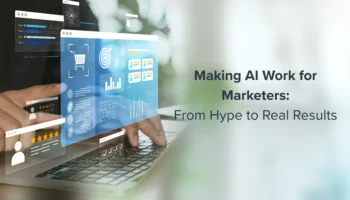Didn’t have a chance to tune in to our latest webinar with SparkPost? In “Using First-Party Data in Email and Beyond,” Marina Ben-Zvi, Director of Product Marketing at Blueshift, and April Mullen, Director of Brand & Content Marketing at SparkPost, discussed how you can use your data in ways that drive true 1:1 connection and maximize the value of your hard-earned data.
Webinar Recap: Using First-Party Data in Email and Beyond with SparkPost

This webinar covers:
- How to collect and leverage your first-party data
- Creative ways to reach your customers across all channels using first-party data, including email and mobile
- Success stories from brands and our own research to show the power of a well-planned strategy
Why is first-party data so important?
First-party data — which comprises data in your CRM/CDP such as customer email addresses, purchase history, behavioral tracking, etc. — lives on your website (meaning you own the data) and is typically supported by all browsers. Third-party cookies, on the other hand, are not owned by your website and are no longer supported by all internet browsers; in fact, Google is removing support for third-party cookies in 2022.
“Marketing has long been addicted to this notion of targeting users using third-party cookies and spending a lot of money on advertising…That’s not how marketing is going to work going forward. Marketing should have always been a long game, and now it’s kind of forcing us to be in this long game.” April Mullen, Director of Brand & Content Marketing at SparkPost
Gone are the days of hemorrhaging money on advertising just to acquire new customers without focusing on retention. Ensuring the lifetime value of a customer is far more sustainable and cost-effective than simply focusing on new customer acquisition.
Marketing as we know it will change.
As a result of the marketing landscape rapidly changing, CMOs need to take a step back and reevaluate their digital approaches.
- Third-party cookies are disappearing: Marketing experts in both large and small business settings are no longer able to rely on third-party cookies for customer targeting due to platform algorithm restrictions.
- First-party data is not a given: Brands have to work hard to get first-party data using engaging customer experiences, but even this landscape is subject to change. For example, Apple recently announced that they will be launching Mail Privacy Protection in fall 2021, limiting marketers’ insight into their customers’ engagement.
- Strengthen value exchange: Brands need to strengthen their value exchange with customers upfront by engaging them with compelling and valuable experiences on their website, then continuing to reinforce brand affinity.
Building your value proposition.
A recent study found that 76% of consumers will share data with brands as long as they receive certain benefits or enriched experiences. One-size-fits-all marketing isn’t the status quo anymore; delivering personalized experiences requires a deep, nuanced, and real-time customer understanding, which requires access to the right data and the ability to mobilize that data across your channels.
“Brands are being squeezed from two sides. On the one hand, there’s this imperative to provide greater privacy, while at the same time, consumers really want more personalized interactions. So why would someone actually want to share their data with your brand or engage on your brand properties? It’s because you provide that value in exchange for their data. Relationships are very much give-and-get. If you provide value and make every interaction enjoyable and personally relevant, consumers will gladly share their data in exchange for that.” Marina Ben-Zvi, Director of Product Marketing at Blueshift
How do you harness and act on the first-party data your brand has at its disposal?
- Centralize your first-party data from across your channels to create a complete view of your customers.
- Have the tools to translate first-party data into better, more connected experiences. These can include:
- Attributes
- Behaviors
- Transactions
In order to unify all these first-party data sources into a comprehensive understanding of your customers, you’ll need a CDP (customer data platform). With a SmartHub Customer Data Platform, you can take your first-party data to the next level by orchestrating customer experiences across channels and triggering the next best action in response to important customer behaviors, events, and milestones.
Want to learn more about how Blueshift’s SmartHub CDP can enhance your first-party data strategy? Watch the full webinar on demand below, then contact one of our first-party data experts at Blueshift today.



